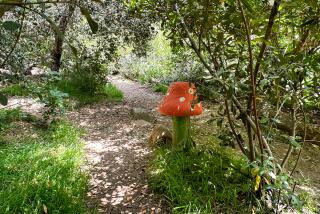Threatened Jays Scrub Florida Park Plan : Maybe birds took up residence <i> after</i> the bush was cleared for surveyors. That still leaves city officials in shock.
PALM BAY, Fla. — City officials say the pair of scrub jays did not even consider moving into the proposed park site until after a strip of brush was cleared for surveyors, turning the land into perfect habitat for the birds.
A federal biologist says the federally protected birds may have been there long before.
No matter.
The jays are there now, and that means Liberty Park, once planned for 40 acres, is going to shrink to no more than 25 acres, and residents of this booming Atlantic Coast city can forget about the community center, the swimming pool and at least one of the four softball fields.
“It’s ironic,” says Fred Poppe, assistant Parks Department director. “Before we cut the survey line, the vegetation was so thick it wasn’t appealing to the birds.
“This property was to be the cornerstone of the park system. We were doing everything right. We’re all pretty much in shock, because we thought we had our ducks lined up.”
But it is not ducks that are flying in the face of development throughout Central Florida. Rather, what has set the stage for a showdown over preservation and property rights is a slender blue-gray bird that relatively few state residents have ever seen.
The Florida scrub jay, listed in 1987 as threatened under the Endangered Species Act, is a cousin of the common blue jay and a subspecies of the scrub jay found in coastal California and elsewhere in the West. Its numbers have declined drastically this century.
Dawn P. Zattau, a biologist with the U.S. Fish and Wildlife Service--and the one who spotted the jays on a final walk-through of the proposed park site last spring--says the number of Florida scrub jays in existence may be less than 10,000, one-half the population of 100 years ago. “It’s in trouble,” she says.
The struggle over the park is a classic confrontation between people and wildlife in an area where the pressure from population growth is intense, and it mirrors a larger battle shaping up in Congress over the future of the 20-year-old Endangered Species Act itself. Critics charge that the balance between saving the environment and the right to develop private property has been tipped in favor of animals and plants.
Here, south of Cape Canaveral along a ridge of dry, sandy soil that is ideal for both the scrub jay and single-family homes, Palm Bay has grown from a town of 18,500 residents in 1980 to more than 70,000 today.
More than 10,000 area residents work for the Harris Corp., a high-tech firm, and a host of smaller aerospace and defense contractors have grown up around it.
Palm Bay officials have struggled to keep up with services and planned to develop Liberty Park on the 40 acres of scrub oak and palmetto palms, purchased for $400,000, to bridge the city’s recreational gap. Along with the pool, community center and ball fields, Liberty Park was also to offer playgrounds, tennis courts and picnic shelters.
But Palm Bay and surrounding Brevard County is also where environmentalists have decided to make a stand on behalf of the scrub jay. In October, the Sierra Club Legal Defense Fund filed notice with the U.S. District Court that it would sue the U.S. Fish and Wildlife Service for not doing enough to protect the bird. The suit would ask for a ban on all development permits in Brevard County until completion of a Habitat Conservation Plan.
“This bird is being nickel-and-dimed to death by development,” says ornithologist Herb Kale, a vice president of the Florida Audubon Society, one of the plaintiffs in the threatened lawsuit. “Something’s got to be done.”
The discovery of the nesting scrub jays has sent Palm Bay planners back to the drawing boards and to the regulatory agencies, and caused some bitterness here. “The birds win and the kids lose,” City Manager Mike Abels complained.
But Zattau, who is serving as the government’s chief scrub jay advocate in several conflicts between the bird and developers, doesn’t share that view. “The kids would lose more if all the scrub jays disappear,” she says. “They are an indicator species for the ecosystem as a whole. There is room for both preservation and development here.”
Zattau says she would like to have at least 20 acres, not just 15, set aside for the two scrub jays and their extended family of three or four others. Negotiations continue over the acreage to be left for Liberty Park.
The Audubon Society’s Kale says whatever that decision, the scrub jay conflict will eventually force the federal government to become more aggressive in protecting Florida’s unique scrub habitat, chiefly by buying lands to see that they are not developed.
In areas where the bird’s habitat has turned into suburbs, Kale said, the friendly, curious scrub jay seems to thrive; it has been known to perch on a person’s head, or eat from a hand. But the mortality rate of fledglings is high, he adds, and the natural cycles of fire that purge the habitat of thick undergrowth are disrupted.
“In a state that’s growing by 900 people a day, it’s one of those inevitable collisions,” says Kale of the conflict between the bird and development.
Palm Bay, meanwhile, has put Liberty Park on hold and is hiring a biologist. “We’re starting all over,” Poppe says.
More to Read
Sign up for Essential California
The most important California stories and recommendations in your inbox every morning.
You may occasionally receive promotional content from the Los Angeles Times.










